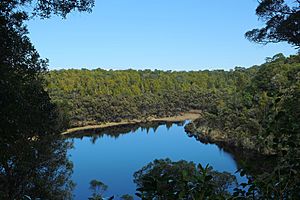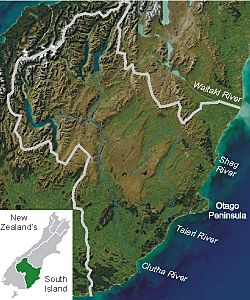Lake Wilkie facts for kids
Quick facts for kids Lake Wilkie |
|
|---|---|

View over Lake Wilkie
|
|
| Location | The Catlins, South Island |
| Coordinates | 46°34′49″S 169°26′20″E / 46.580309°S 169.438813°E |
| Type | Bog lake |
| Primary inflows | None |
| Primary outflows | None |
| Basin countries | New Zealand |
| Surface area | 1.7 hectares (4.2 acres) |
| Average depth | 1.5 metres (5 ft) |
| Max. depth | 2 metres (7 ft) |
| Surface elevation | 15 metres (49 ft) |
Lake Wilkie is a small, beautiful lake. You can find it near Tautuku Bay in the Catlins, a special area in the south of New Zealand. It's located south of the city of Dunedin.
This lake formed after the last ice age. Over thousands of years, it has slowly become smaller. Today, it covers about 1.7 hectares (4.2 acres). Lake Wilkie is a bog lake, which means it's a rare and important type of ecosystem in this part of New Zealand.
Contents
How Lake Wilkie Formed
Lake Wilkie began to form about 13,000 years ago. This was after the most recent ice age ended. Water collected in a low area between old sand dunes. A small cliff near the coast trapped the water.
When it first formed, the lake was much bigger. Over time, plants have slowly filled in parts of the lake. This process is still happening today. The lake is now very shallow. Its water looks brownish because of natural acids from the peaty soil around it.
Animals and Plants of Lake Wilkie
Lake Wilkie is home to many small creatures. You can find tiny plankton and small invertebrates here. These include mites, molluscs, water boatmen, and worms. No fish have been found in the lake itself. However, native galaxias fish might live nearby.
The whistling tree frog is very common around the edges of the lake. There's even a cafe named "The Whistling Frog Cafe & Bar" about 7 kilometres (4 mi) from the lake.
Birds Around the Lake
Many birds live in the forest around Lake Wilkie. Some common birds you might see are the kererū, tui, silvereye, fantail, bellbird, brown creeper, and grey warbler. Fernbirds and ducks often visit the lake from the nearby Tautuku Estuary.
Plant Life and Succession
The area around Lake Wilkie shows how different plants grow and change over time. This is called plant succession. You can see this change in a very short distance, about 65 metres (213 ft).
The process starts with marsh areas. These are full of sphagnum moss and sedges. As you move away from the water, these plants are slowly replaced by larger ones. Eventually, you reach the tall podocarp forest. This forest now covers the ancient sand dunes around the lake. It's a great example of how plants can reclaim land and change the landscape.
Visiting Lake Wilkie
Lake Wilkie is easy to visit. It's just a short walk from a small car park. This car park is on the Southern Scenic Route road. It's about 500 metres (0.3 mi) south of the Tautuku Outdoor Education Centre.
A walking track leads you through a beautiful forest. This forest has old rata trees and other large podocarp trees. The track goes past a viewpoint where you can see the whole lake. Then, it leads down to the lake's edge.
At the lake, there's a short loop track with a boardwalk. This boardwalk helps you walk through the boggy wetland right next to the lake. Along the track, you'll find signs that explain the different types of plants you see. They show how the plants change as the land slowly gets reclaimed from the water.
See also

- In Spanish: Lago Wilkie para niños


